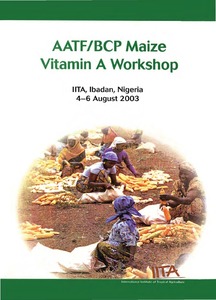| dc.contributor.author | Fakorede, M.A.B. |
| dc.contributor.author | Fajemisin, J. |
| dc.contributor.author | Ladipo , J. |
| dc.contributor.author | Ajala, S. |
| dc.contributor.author | Kim, S.K. |
| dc.date.accessioned | 2019-12-04T11:24:12Z |
| dc.date.available | 2019-12-04T11:24:12Z |
| dc.date.issued | 2003 |
| dc.identifier.citation | Fakorede, M.A.B., Fajemisin, J.M., Ladipo, J.L., Ajala, S.O. & Kim, S.K. (2003). Development and regional deployment of streak virus resistant maize germplasm: an overview. In Proceedings of a conference on Plant Virology in Sub Saharan Africa, 4-8 June 2001, Ibadan, Nigeria, (pp. 503-516). |
| dc.identifier.isbn | 978-131-214-9 |
| dc.identifier.uri | https://hdl.handle.net/20.500.12478/4306 |
| dc.description.abstract | The Maize streak virus (MSV) disease has been one of the most devastating diseases of maize (Zea mays L.) in all the countries of West and Central Africa (WCA). For a long time, breeding for resistance to the disease was frustrating because of lack of facilities for uniform artifi cial inoculation. In 1975, a collaborative project involving the International Institute of Tropical Agriculture (IITA), the International Maize and Wheat Improvement Center (CIMMYT), and the national agricultural research systems (NARS) of West and Central Africa was initiated with emphasis on breeding streak resistant (SR) maize germplasm. The scientists developed reliable screening methods for Maize streak virus resistance. They also identifi ed and developed an effective rearing method for the most active vector of the virus (Cicadulina triangula) for virus transmission. The scientists identified sources of resistance, studied the genetics of resistance, and screened
for resistance thousands of lines and populations from CIMMYT, IITA, and NARS of WCA and other parts of the world. Using the backcross breeding method, breeders converted established varieties and breeding populations from different sources to SR. In 1988 when the project was terminated, most of the available breeding populations and lines from CIMMYT and IITA, and many elite varieties from the NARS had been converted to SR and many NARS scientists had been trained to carry out SR conversion at the national level. Artifi cial infestation of breeding materials with viruliferous C. triangula is now a standard practice of maize breeders at IITA and in many national programs. Also, IITA has been distributing primarily SR maize germplasm to African countries and beyond. All maize varieties released in WCA countries in the last two decades are streak resistant. The payoff from these efforts is that MSV is no longer a serious threat to maize production in WCA. Crop scientists may emulate the example of this collaborative effort in a bid to eradicate other virus diseases. |
| dc.language.iso | en |
| dc.subject | Maize |
| dc.subject | Viruses |
| dc.subject | Disease Resistance |
| dc.title | Development and regional deployment of streak virus resistant maize germplasm: an overview |
| dc.type | Conference Paper |
| dc.type | Conference Paper |
| dc.description.version | Peer Review |
| cg.contributor.affiliation | Obafemi Awolowo University |
| cg.contributor.affiliation | International Institute of Tropical Agriculture |
| cg.coverage.region | Africa |
| cg.coverage.region | West Africa |
| cg.coverage.country | Nigeria |
| cg.authorship.types | CGIAR and developing country institute |
| cg.iitasubject | Maize |
| cg.accessibilitystatus | Limited Access |
| local.dspaceid | 99872 |

